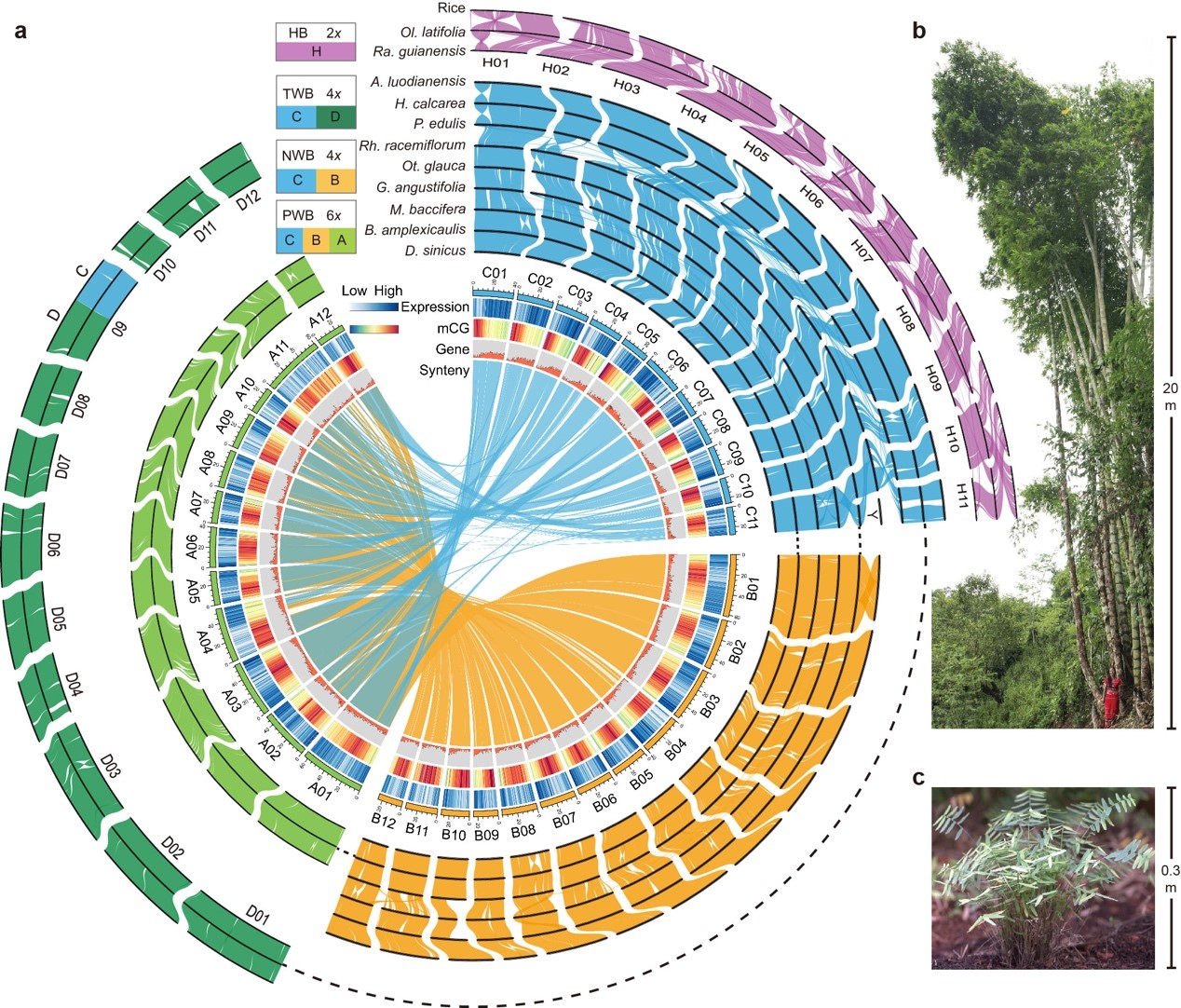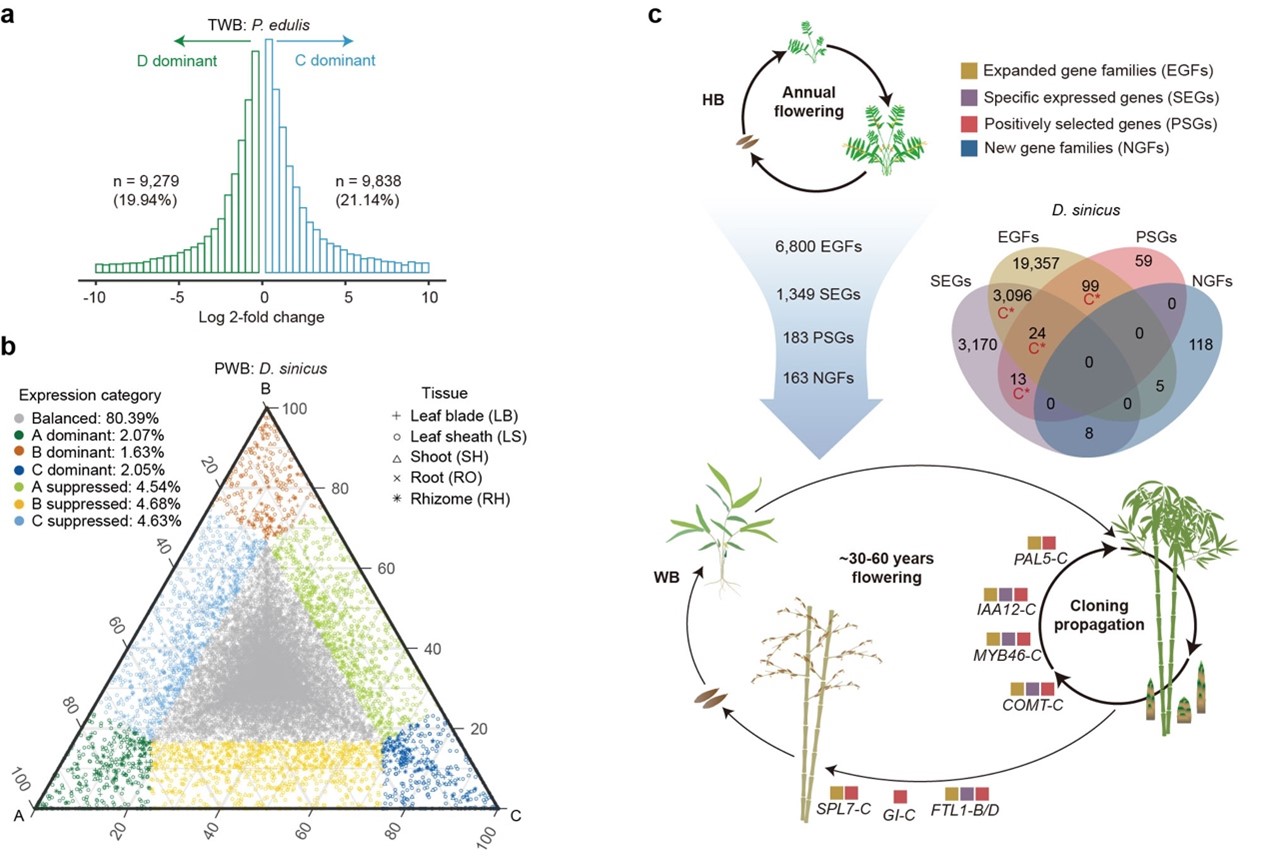As a major driving force of evolution, polyploidy (genome duplication) is ubiquitous across different evolutionary stages of the flowering plant tree of life. However, the interactions between the ancestral genomes in a polyploid nucleus, often involving subgenome dominance, have been poorly understood.
Bamboos show great diversity in species and morphology, consisting of a minor herbaceous, mostly diploid clade (~126 species) and three major polyploid woody clades (~1,576 species). As one of the most important lineages of plants that has adapted to a forest habitat, woody bamboos (WBs) exhibit distinctive biological traits, such as rapid growth (up to 114.5 cm/day) and synchronous, usually monocarpic, flowering (~30-60 years).
A research team led by Prof. LI Dezhu from the Kunming Institute of Botany (KIB) of the Chinese Academy of Sciences (CAS), in collaboration with scientists from the United States, has proposed a refined model for the origin and polyploidization of woody bamboo.
Their studies revealed recurrent hybridization events between diploid ancestors of woody lineages followed by polyploidization, together with introgression between ancestral woody and herbaceous lineages, early in the evolution of bamboo.
LI's team has long been dedicated to systematic and evolutionary studies of bamboo. In their previous work reporting draft genomes for four bamboo species, they proposed a reticulate origin for WBs involving hybridization and polyploidization.
"To conduct a more comprehensive study of bamboos across different ploidy levels and broad phylogenetic diversity, we sampled two herbaceous bamboos and three representative species from each woody lineage," said LI.
Supported by the Germplasm Bank of Wild Species of KIB, the international team successfully acquired chromosome-level genome sequences of 11 representative bamboo species using third-generation sequencing technology. They collected and sequenced transcriptome data from 476 bamboo samples covering different tissues and different growth stages.
Using a multi-omics approach, the team confirmed the presence of four distinct subgenomes of WBs: A, B, C and D.
Further investigation revealed that the WBs exhibit remarkable karyotype stability, maintaining the ancestral state of 12 grass family chromosomes at the subgenome level, despite 12 to 20 Ma since polyploidization and subsequent large-scale species diversification.
"Our study suggests a clear dominance of the C subgenomes in two tetraploid lineages, as reflected in a series of features, including genome size, gene fractionation, genomic rearrangements, transposable elements, and gene expression," said LI.
However, the pattern of dominance in the hexaploid lineage is more dynamic, with a gradual shift in dominance from the C to the A subgenome.
Further analysis revealed that the dominant C subgenome, together with the A subgenome in the hexaploid clade, contributed the most to the evolution of distinctive traits in WBs and possibly their adaptive radiation into a forest habitat.
This work highlights the utility of using clade-wide genome sequence assemblies to advance our understanding of subgenome evolution in polyploid plants.
Results of this work were published online in Nature Genetics in an article entitled "Genome assemblies of 11 bamboo species highlight diversification induced by dynamic subgenome dominance."
This study was supported by the Strategic Priority Research Program of CAS, the National Natural Science Foundation of China, and the Leading Talents Program of Yunnan Province, China.

Model for the origins and evolutionary history of diploid bamboo ancestors and the polyploidization events in three woody clades. (Image by KIB)

Overview of syntenic landscape of sequenced genomes of two herbaceous bamboos and three representative species from each woody clade, and size difference between Dendrocalamus sinicus (b), a hexaploid woody species, and Raddia guianensis (c), a diploid herbaceous species. (Image by KIB)

Histograms (a) and ternary plot (b) of homoeologs for expression bias in representative species of tetraploid and hexaploid clades of woody bamboos and life history transition from herbaceous to woody bamboos with underlying genetic alterations (c). (Image by KIB)






